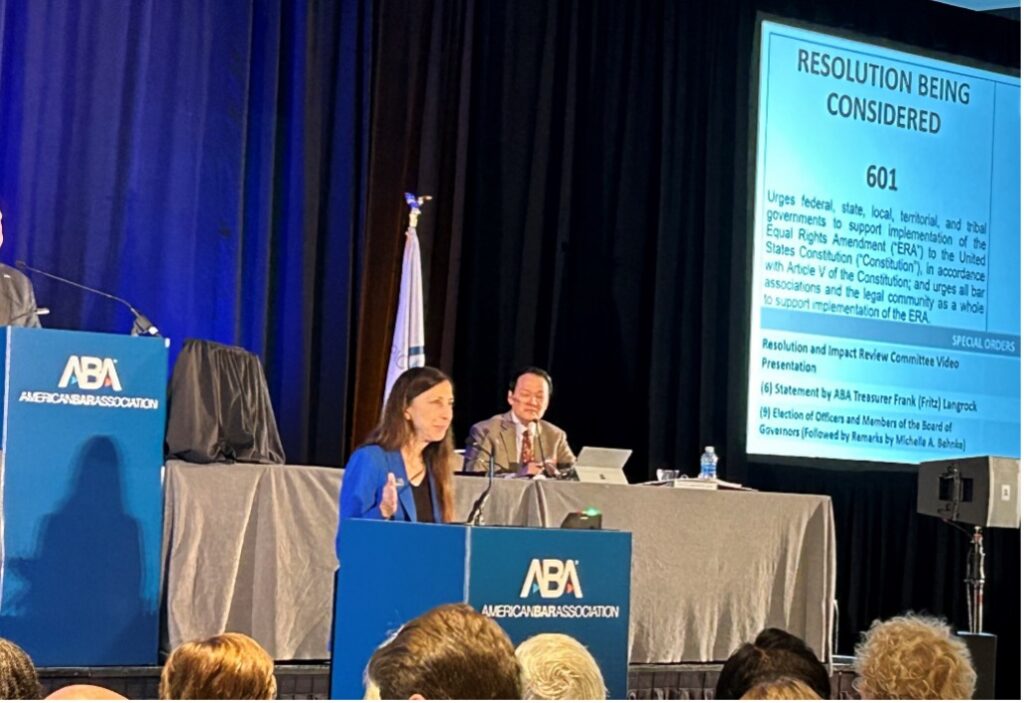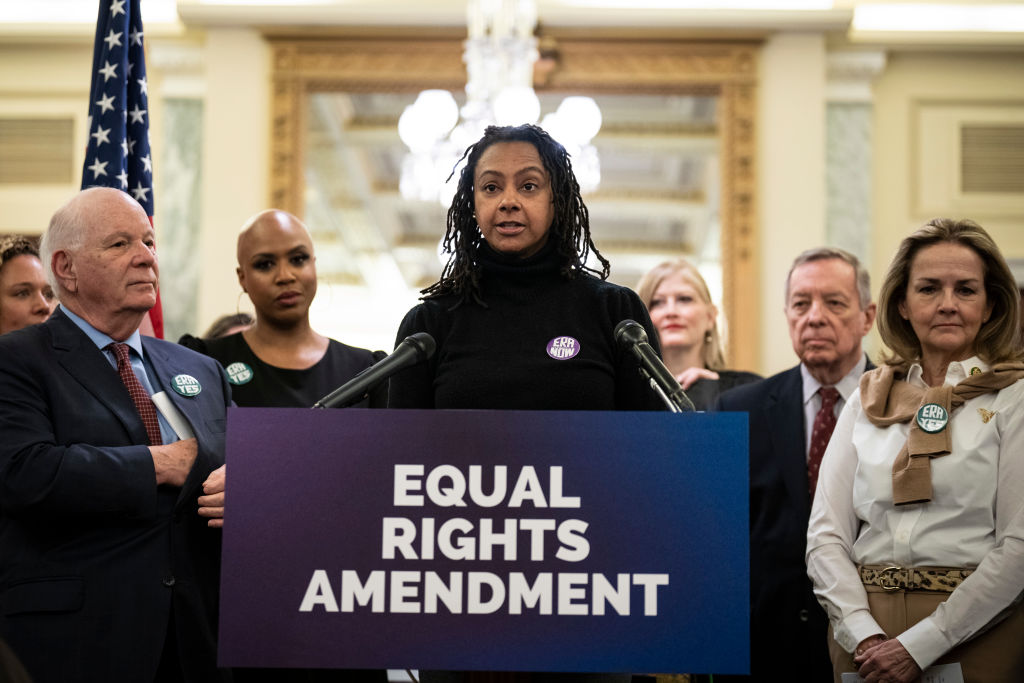“The ERA is now more important—and more urgent—than ever before,” said Karol Corbin Walker, chair of the ABA’s Commission on Women in the Profession.

At the annual meeting of the American Bar Association in Chicago on Aug. 6, the association’s House of Delegates adopted a resolution declaring the Equal Rights Amendment fully ratified as the 28th Amendment to the U.S. Constitution. The ABA resolution urged full implementation of the ERA by the legal community and all federal, state, local, territorial and tribal governments. The ABA has a membership of 400,000 lawyers.
“This is BIG news,” said U.S. Senator Kirsten Gillibrand, a leading ERA advocate. “The leading association for legal minds just endorsed our position that the Equal Rights Amendment has satisfied every constitutional requirement and called on the entire legal community to support certifying and publishing the ERA as our 28th Amendment.”
Chicago-based attorney Linda Coberly, the legal strategy advisor for the ERA Coalition, agreed: “The ABA is a large and powerful organization, and its support of the Equal Rights Amendment is an important statement.”
The resolution counters two arguments of ERA opponents:
- that the ratification is invalid because Congress placed a seven-year time limit for ratification in the preamble to the ERA passed in 1972 (later extended another three years), and
- that six states that ratified the ERA have validly rescinded their ratifications.
The ABA resolution states that Article V of the Constitution, which sets out how the Constitution can be amended, does not allow Congress to place a time limit on ratification, nor does it allow states to rescind their ratifications of an amendment.
“Congress cannot unilaterally change the process for amending the Constitution,” said Karol Corbin Walker, chair of the ABA’s Commission on Women in the Profession, which submitted the resolution. “This resolution will empower the ABA to speak out to answer the claims of ERA opponents in Congress, in the executive branch and in the courts.”
The ABA has long supported the ERA, adopting pro-ERA resolutions in 1972, 1974 and 2016, but the Aug. 6 resolution is the first resolution passed since full ratification of the ERA in 2020 and the first to call for implementation of the ERA. The resolution in effect recognizes that the ERA is the 28th Amendment to the U.S. Constitution.
Former ABA president Mary Smith, who testified in favor of the resolution before the House of Delegates, said afterwards, “Many of us have been working on women’s issues for decades. I think about the women who came before us like Ida Wells and Dorothy Height. We’re still fighting the fight.”

Winning the ABA Resolution Supporting the ERA
In May of 2023, for the 100th anniversary of the ERA and in anticipation of a United Nations Human Rights Committee report condemning the United States’ failure to ratify the ERA, Judge Delissa Ridgway organized a program on the ERA at the annual conference of the ABA’s International Law Section. Ridgway is a senior judge on the U.S. Court of International Trade in New York. The speakers included Ridgway, Georgetown Law professor Victoria Nourse and ERA Coalition founder Jessica Neuwirth, with former ABA president Karen Mathis moderating. They explained how the ERA was fully ratified as of 2020, but that certification and publication were blocked by the Trump administration.
“The energy in the room was so phenomenal,” Ridgway told Ms. “People were 100 percent engaged—and outraged.”
When the ABA Women’s Caucus met at the ABA’s Annual Meeting in Denver in August 2023, Ridgway and Illinois attorney Michele Thorne pitched the idea of an updated ABA resolution on the ERA. Thorne had been very active in the Illinois ratification effort in 2018.
The Commission on Women in the Profession agreed to sponsor an ERA resolution and created an ERA Committee, which included Penny Christophorou, Lakshmi Gopal, Deena Hurwitz, Linda S. Parks, Judge Ridgway, Michele Thorne and Beth Whittenbury. They recruited four other sponsors for the resolution, including the ABA Section on Civil Rights and Social Justice, the ABA International Law Section, the ABA Center for Human Rights and the New York City Bar Association. Ridgway, Hurwitz, Thorne and Gopal drafted the report that accompanied the resolution.
The 15-page report supporting the resolution makes the case for the importance of the ERA, especially today with a Supreme Court embracing a theory of originalism that would reverse many hard-won rights for women. The report explains that “existing federal and state laws prohibiting sex discrimination are—at best—a patchwork” because Congress can amend or repeal anti-discrimination laws and the Supreme Court can interpret them narrowly based on social or political bias, “stripping them of much of their force and effectiveness. … Statutory provisions thus lack the permanence and authority that constitutional protection of the equality of the sexes would afford.”
The report explains why ABA recognition of the ERA is so important: “The American Bar Association prides itself as ‘the largest voluntary association of lawyers in the world’ and ‘the national voice of the legal profession.’ Particularly in this momentous Presidential election year, with women’s rights on the ballot, the ABA must be prepared to speak on the procedural issues that continue to be raised as to recognition of the ERA as the 28th Amendment to the U.S. Constitution.”
At the Aug. 6 ABA meeting, on the floor of the House of Delegates, Ridgway and her allies distributed 350 of the iconic green “ERA Yes” buttons.
“It was a sea of green,” said Ridgway.
They lined up nearly 40 people to speak in favor of the resolution. All seven female former presidents in attendance were prepared to make remarks and three of the male former presidents, with the other four female former presidents not in attendance in strong support. “All of the women former presidents consistently and repeatedly pledged their enthusiastic, unqualified, impassioned support for the resolution,” said Judge Ridgway.
Because there was no formal opposition to the resolution, only four people ended up speaking: Corbin Walker, Coberly, Smith and Joseph Raia, a delegate from the ABA’s International Law Section.
“We can and should recognize the ERA because it is an exercise of hope for our democracy, ratified by a diverse and bipartisan group of state legislators, carrying out a power that the federal Constitution places in their hands,” said Coberly.
The resolution passed by acclamation, with one lone male voice voting against the resolution out of 546 delegates representing states, ABA sections and divisions, state and local bar associations and specialty bar associations.
“There’s usually greater opposition to resolutions,” said Ridgway. “The lack of opposition here speaks volumes to the strength and importance of the ERA. We worked hard to ensure that the report refuted the arguments of ERA opponents and spelled out all the arguments for why the ERA has been fully ratified and must be recognized—today—as the 28th Amendment.”

Several supporters say they worry the current Supreme Court might overturn a longstanding precedent that the 14th Amendment Equal Protection Clause provides certain equality protections to women. “We’ve seen the Supreme Court roll back protections that had been in existence for decades,” said Smith, speaking in her personal capacity after she stepped down as ABA president at the end of last week’s Chicago meeting.
Smith emphasized the importance of the ERA: “It is foundational to democracy that women have equal rights to fully participate in our democracy. We make up half of the population but unfortunately, we’re lagging in so many areas like equal pay and equal representation in the legal profession.”
Smith, who is Indigenous, added: “Any law that strengthens the rights of women lifts all women up, whether they’re Indigenous, Black, Asian, Hispanic. The ERA lifts all of us up.”
Accompanying the report is an explanation regarding plans for implementation of the resolution, including the ABA writing letters to Congress, urging the national archivist to certify and publish the ERA as the 28th Amendment, and filing briefs with the U.S. Supreme Court and Courts of Appeals. Backers of the resolution are confident that the ABA will act on the resolution. They also urge bar associations to audit federal and state laws for compliance with the ERA.
Coberly believes it is important that Congress adopt a joint resolution declaring the ERA to be the 28th Amendment, notwithstanding the time frame set forth in the resolution Congress used to send the ERA out to the states for ratification. “As a matter of constitutional law, the ERA today is part of the Constitution, but it would be better if we also had Congress remove the time frame because doing so would give us additional arguments when this issue inevitably reaches the courts.”
Judge Ridgway agrees: “The ERA instantaneously and automatically became the 28th Amendment when Virginia ratified back in January 2020. No further action is necessary, but the bills in Congress and publication by the archivist would go a long way toward moving the ball forward and getting the rest of the world to recognize the ERA as the 28th Amendment.”
ERA advocates plan to send the ABA resolution and report to key members of Congress, where supporters like Senator Gillibrand can use it to push for passage of a joint Congressional resolution recognizing the ERA as the 28th Amendment to the U.S. Constitution.
“A national Equal Rights Amendment would be the most effective direct rebuttal to Dobbs and it would ensure American women and girls have their freedom and equality guaranteed in the Constitution,” said Sen. Gillibrand.”
Read Linda Coberly’s full remarks in support of the resolution below, or watch the full remarks here:
“The ERA equality guarantee is just as important today as it was more than 100 years ago when it was first introduced in Congress. And if you’re not sure about that, just read the decisions of our Supreme Court over the last couple of years. Those decisions teach us again and again that we shouldn’t rely on anything that isn’t in the text of the Constitution, and equality based on sex should be in the text of the Constitution.
“Every Constitution passed and written in the world since World War II includes a guarantee of equality of rights under the law on account of sex. Every constitution. We are in a minority of developed countries who lack this protection, and it is an essential signal, symbol and conferral of rights to women and girls and everyone in the United States.
“We can and should recognize the ERA as lawyers in accordance with our promise to uphold and protect the Constitution, including the process it establishes for amendment, which has now been met by the Equal Rights Amendment with the last three ratifications.
“We can and should make it a legislative priority to ask our representatives in Congress to eliminate any doubt and remove the seven-year time frame that Congress had in mind when it passed the ERA in 1972. There can be no time limit on equality.
“We can and should recognize the ERA because it is an exercise of hope for our democracy, ratified by a diverse and bipartisan group of state legislators, carrying out a power that the federal Constitution places in their hands.
“We can and should be advocates for equality in all aspects of our civic life, and particularly for equality of rights under the law.”
Fifty-Year Campaign for the ERA
Article V of the U.S. Constitution sets out two requirements for amendments: approval by two-thirds of both chambers of Congress, and ratification by three-fourths (38) of the states.
In 1971, the U.S. House of Representatives approved the ERA with a bipartisan vote of 354-24.
The next year, the Senate approved the ERA by another bipartisan vote of 84-8.
In the preamble to the ERA, Congress created a seven-year timeline for ratification. Over those seven years—between 1972 and 1979—35 states ratified the ERA. Then Congress extended the timeline to 1982 but no more states ratified the ERA … until after Donald Trump became president in 2017 and began furiously rolling back women’s rights, spurring ERA supporters to mobilize a renewed effort to achieve full ratification of the ERA. Nevada ratified the ERA in 2017, Illinois in 2018 and Virginia in 2020, achieving full ratification by 38 states as required by Article V.
The final ministerial step to make a constitutional amendment official is for the national archivist to verify the ratifications and draft a formal proclamation certifying that the amendment is valid and is part of the Constitution. This certification is then published in the Federal Register and U.S. Statutes at Large and serves as official notice to Congress and the nation that the amendment process has been completed.

These final steps never happened because the Trump-era Department of Justice’s Office of Legal Counsel issued a 38-page opinion arguing that the recent ratifications were invalid. The Trump administration argued the last three ratifications came too late and that the number of ratifications fell short because several states that had previously ratified the ERA—Nebraska, Tennessee, Idaho, Kentucky, South Dakota and North Dakota—claimed to have rescinded their ratifications.
In 2020, the Biden administration’s Justice Department issued an updated legal opinion stating that Congress has the power to remove the timeline and declare the ERA ratified.
ERA advocates unsuccessfully filed lawsuits to force the national archivist to certify and publish the amendment, and they have also lobbied Congress to pass a resolution removing the timeline and declaring the ERA fully ratified. The House of Representatives three times passed a joint resolution declaring the ERA validly ratified—in February 2020, March 2021 and January 2023—but Republicans used the filibuster to block the measure in the Senate.
Up next:
U.S. democracy is at a dangerous inflection point—from the demise of abortion rights, to a lack of pay equity and parental leave, to skyrocketing maternal mortality, and attacks on trans health. Left unchecked, these crises will lead to wider gaps in political participation and representation. For 50 years, Ms. has been forging feminist journalism—reporting, rebelling and truth-telling from the front-lines, championing the Equal Rights Amendment, and centering the stories of those most impacted. With all that’s at stake for equality, we are redoubling our commitment for the next 50 years. In turn, we need your help, Support Ms. today with a donation—any amount that is meaningful to you. For as little as $5 each month, you’ll receive the print magazine along with our e-newsletters, action alerts, and invitations to Ms. Studios events and podcasts. We are grateful for your loyalty and ferocity.



